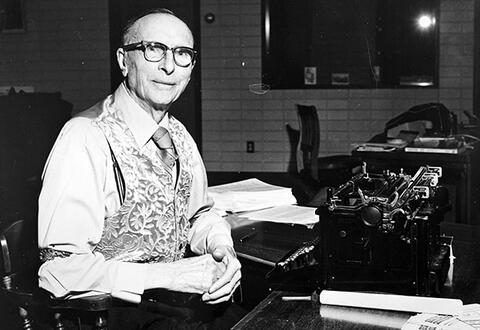
Title and statement of responsibility area
Titel
Dr. George Shepherd
Algemene aanduiding van het materiaal
- Graphic material
Parallelle titel
Overige titelinformatie
Title statements of responsibility
Titel aantekeningen
Beschrijvingsniveau
Stuk
archiefbewaarplaats
referentie code
Editie
Editie
Edition statement of responsibility
Class of material specific details area
Statement of scale (cartographic)
Statement of projection (cartographic)
Statement of coordinates (cartographic)
Statement of scale (architectural)
Issuing jurisdiction and denomination (philatelic)
Datering archiefvorming
Datum(s)
-
Apr. 1974 (Vervaardig)
Fysieke beschrijving
Fysieke beschrijving
1 negative : b&w ; 4.5 x 7 cm
Publisher's series area
Title proper of publisher's series
Parallel titles of publisher's series
Other title information of publisher's series
Statement of responsibility relating to publisher's series
Numbering within publisher's series
Note on publisher's series
Archivistische beschrijving
Naam van de archiefvormer
Geschiedenis beheer
Bereik en inhoud
Image of Dr. George Shepherd, first curator, Saskatoon Western Development Museum, at work. Image taken at the time of presentation of an honourary Doctor of Laws degree by the University of Saskatchewan in May 1974.
Bio/Historical Note: Dr. George Shepherd was born in 1890 in Canterbury, England. George and his father immigrated to Canada in 1908, settling near Davidson, Saskatchewan, that fall. The following year, his mother, sister and five brothers joined them in Canada. In 1913 Dr. Shepherd took up a purchased homestead 80 kilometres south of Maple Creek. The land there nourished his interest in the early history of the Northwest Mounted Police and Fort Walsh. Working with the late Commissioner Stuart Taylor Wood, Dr. Shepherd helped with the purchase of the fort for raising police horses. As a part of the community of cattlemen in the Cypress Hills, his knowledge of the history of the West grew. After years of ranching and farming, Dr. Shepherd and his family retired to Saskatoon in 1950. He quickly became active in the life of the city and the nearby university. Three years after moving to Saskatoon, Dr. Shepherd was made curator of the fledgling Western Development Museum, housed in a re-assembled Second World War hangar on 11th Street West. He greeted many thousands of visitors, including Her Majesty Queen Elizabeth and the Duke of Edinburgh in 1959. In 1965 Dr. Shepherd published his first book, West of Yesterday, followed in 1967 by Brave Heritage. He also authored many articles in western Canadian history for a variety of periodicals and magazines. In 1972 when the WDM Saskatoon moved from 11th Street West to Lorne Avenue, the Museum’s collection of library and heritage resources was officially named the George Shepherd Library. He altered his bus route, but not his routine, arriving every weekday morning at the new Museum, anticipating his day of greeting visitors from near and far. In recognition of his years of service to Saskatchewan, Dr. Shepherd was presented with an honourary Doctor of Laws degree in 1976 by the University of Saskatchewan. In 1977 he received an Honourary Scroll from the Government of Saskatchewan. He was honoured that same year when a seniors’ high-rise at 525-24th Street East in Saskatoon was named Shepherd Apartments. Until 87 years of age, Dr. Shepherd arrived faithfully at the Museum five days a week, ready to greet visitors and share stories of Saskatchewan. In October 1977, he said farewell to Museum work. George Shepherd died in February 1978.
Aantekeningen
Materiële staat
Directe bron van verwerving
Ordening
Taal van het materiaal
Schrift van het materiaal
Plaats van originelen
Beschikbaarheid in andere opslagformaten
Restrictions on access
There are no restrictions on access.
Termen voor gebruik, reproductie en publicatie.
Photographer: Unknown
Copyright holder: Unknown
Copyright expires: Unknown
Other terms: Responsibility regarding questions of copyright that may arise in the use of any images is assumed by the researcher.
Toegangen
Associated materials
Aanvullingen
Location note
Neg. Vol. 13

